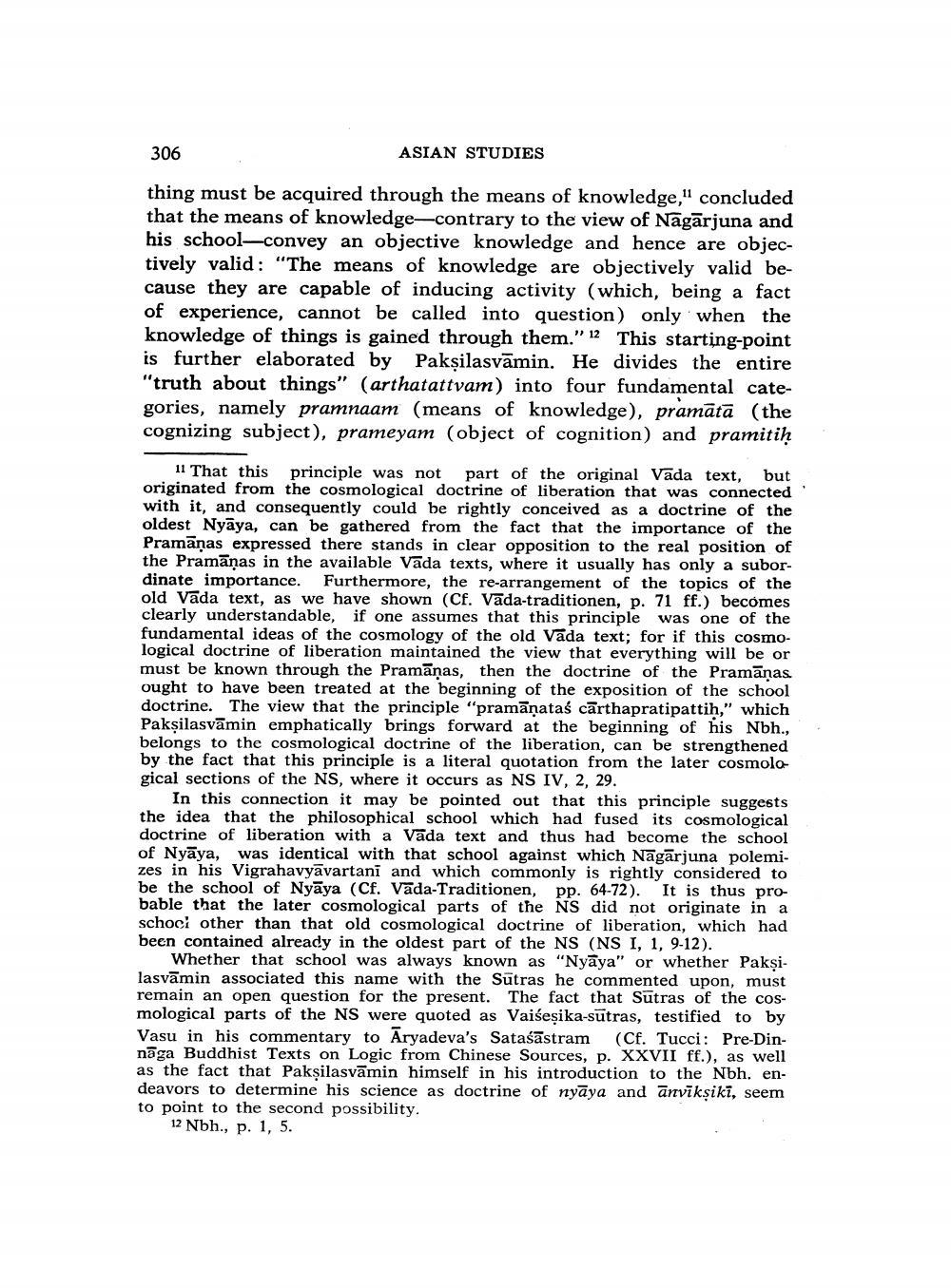________________
306
thing must be acquired through the means of knowledge," concluded that the means of knowledge-contrary to the view of Nagarjuna and his school-convey an objective knowledge and hence are objectively valid: "The means of knowledge are objectively valid because they are capable of inducing activity (which, being a fact of experience, cannot be called into question) only when the knowledge of things is gained through them." This starting-point is further elaborated by Pakṣilasvamin. He divides the entire "truth about things" (arthatattvam) into four fundamental categories, namely pramnaam (means of knowledge), pramātā (the cognizing subject), prameyam (object of cognition) and pramitiḥ
ASIAN STUDIES
11 That this principle was not part of the original Vada text, but originated from the cosmological doctrine of liberation that was connected with it, and consequently could be rightly conceived as a doctrine of the oldest Nyaya, can be gathered from the fact that the importance of the Pramāņas expressed there stands in clear opposition to the real position of the Pramaņas in the available Vāda texts, where it usually has only a subordinate importance. Furthermore, the re-arrangement of the topics of the old Vada text, as we have shown (Cf. Vada-traditionen, p. 71 ff.) becomes clearly understandable, if one assumes that this principle was one of the fundamental ideas of the cosmology of the old Vada text; for if this cosmological doctrine of liberation maintained the view that everything will be or must be known through the Pramaņas, then the doctrine of the Pramāņas. ought to have been treated at the beginning of the exposition of the school doctrine. The view that the principle "pramāṇataś carthapratipattih," which Pakṣilasvamin emphatically brings forward at the beginning of his Nbh., belongs to the cosmological doctrine of the liberation, can be strengthened by the fact that this principle is a literal quotation from the later cosmological sections of the NS, where it occurs as NS IV, 2, 29.
In this connection it may be pointed out that this principle suggests the idea that the philosophical school which had fused its cosmological doctrine of liberation with a Vada text and thus had become the school of Nyaya, was identical with that school against which Nagarjuna polemizes in his Vigrahavyāvartani and which commonly is rightly considered to be the school of Nyaya (Cf. Vada-Traditionen, pp. 64-72). It is thus probable that the later cosmological parts of the NS did not originate in a schoci other than that old cosmological doctrine of liberation, which had been contained already in the oldest part of the NS (NS I, 1, 9-12).
Whether that school was always known as "Nyaya" or whether Paksilasvamin associated this name with the Sutras he commented upon, must remain an open question for the present. The fact that Sutras of the cosmological parts of the NS were quoted as Vaiśeṣika-sutras, testified to by Vasu in his commentary to Aryadeva's Sataśastram (Cf. Tucci: Pre-Dinnaga Buddhist Texts on Logic from Chinese Sources, p. XXVII ff.), as well as the fact that Pakṣilasvamin himself in his introduction to the Nbh. endeavors to determine his science as doctrine of nyaya and anvikṣiki, seem to point to the second possibility.
12 Nbh., p. 1, 5.




